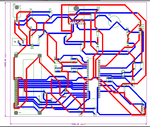HAIDE
Junior Member level 3
Hi,
I design a circuit by DC motor, which controlled by micro controller(using PWM), I want to control a 24 volt dc motor by L298, I have designed a schematic file but I'm not sure this is works, I atached the both schematcs in pdf and a part of circuit in image and also PCB, any idea?:idea:
Also another question is L298 is proper choice to control 24 volt DC motor?
I design a circuit by DC motor, which controlled by micro controller(using PWM), I want to control a 24 volt dc motor by L298, I have designed a schematic file but I'm not sure this is works, I atached the both schematcs in pdf and a part of circuit in image and also PCB, any idea?:idea:
Also another question is L298 is proper choice to control 24 volt DC motor?

